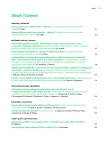-
Medical journals
- Career
An assessment of VO2 kinetics in the recovery phase of cardiopulmonary exercise test in patients with heart disease – importance and classification
Authors: Leona Mífková; František Várnay; Pavel Homolka; Petr Dobšák
Authors‘ workplace: Klinika tělovýchovného lékařství a rehabilitace LF MU a FN u sv. Anny v Brně
Published in: Vnitř Lék 2017; 63(2): 107-113
Category: Reviews
Overview
The article reviews the course of VO2 in the phase of recovery kinetics of oxygen uptake (VO2rec) cardiopulmonary exercise test. VO2rec kinetics cannot be completely defined using a single parameter. The article describes the three most frequently used methods: %VO2-REC2, T1/2 VO2rec and TC VO2, and provides detailed procedures of their analysis. The three aforementioned parameters are also at the heart of our classification of VO2rec. The method %VO2-REC2 is an essential one, in our view, since its prognostic significance is proven and it can be also easily applied only based on a data record of the cardiopulmonary exercise test. %VO2-REC2 should be seen, together with VO2peak, VE/VCO2 slope and exercise oscillatory ventilation (EOV) – as one of the four elementary prognostic markers establishing an advanced chronic heart failure.
Key words:
cardiopulmonary exercise test – chronic heart failure – prognosis – recovery kinetics of oxygen uptake
Sources
1. Guazzi M, Adams V, Conraads V et al. EACPR/AHA Scientific Statement. Clinical Recommendations for Cardiopulmonary Exercise Testing Data Assessment in Specific Patient Populations. Eur Heart J 2012; 33(23): 2917–2927. Dostupné z DOI: <http://dx.doi.org/10.1093/eurheartj/ehs221>.
2. Guazzi M, Ross A, Halle M et al. EACPR/AHA Scientific Statement. 2016 Focused Update: Clinical Recommendations for Cardiopulmonary Exercise Testing Data Assessment in Specific Patient Populations. Circulation 2016; 133(24): e694-e711. Dostupné z DOI: <http://dx.doi.org/10.1161/CIR.0000000000000406>.
3. Daida H, Allison TG, Johnson BD et al. Further Increase in Oxygen Uptake During Early Active Recovery Following Maximal Exercise in Chronic Heart Failure. Chest 1996; 109(1): 47–51.
4. Kriatselis ChD, Nedios S, Kelle S et al. Oxygen Kinetics and Heart Rate Response during Early Recovery from Exercise in Patients with Heart Failure. Cardiol Res Pract 2012; 2012 :512857. Dostupné z DOI: <http://dx.doi.org/10.1155/2012/512857>.
5. Hayashida W, Kumada T, Kohno F et al. Post-exercise oxygen uptake kinetics in patients with left ventricular dysfunction. Int J Cardiol 1993; 38(1): 63–72.
6. Mann TN, Webster Ch, Lamberts TP et al. Effect of exercise intensity on post-exercise oxygen consumption and heart rate recovery. Eur J Appl Physiol 2014; 114(9): 1809–1820. Dostupné z DOI: <http://dx.doi.org/10.1007/s00421–014–2907–9>.
7. DeGroote P, Millaire A, Decloux E et al. Kinetics of Oxygen Consumption During and After Exercise in Patients With Dilated Cardiomyopathy. New Markers of Exercise Intolerance With Clinical Implications. J Am Coll Cardiol 1996; 28(1): 168–175.
8. Pavia L, Myers J, Cesare R. Recovery Kinetics of Oxygen Uptake and Heart Rate in Patients With Coronary Artery Disease and Heart Failure. Chest 1999; 116(3): 808–813.
9. Queirós MC, Mendes M, Ribeiro MA et al. Recovery kinetics of oxygen uptake after cardioupulmonary execise test and prognosis in patients with left ventricular dysfunction. Rev Port Cardiol 2002; 21(4): 383–398.
10. Fortin M, Turgeon PY, Nadreau E et al. Prognostic Value of Oxygen Kinetics during Recovery From Cardiopulmonary Exercise Testing in Patients With Chronic Heart Failure. Can J Cardiol 2015; 31(10): 1259–1265. Dostupné z DOI: <http://dx.doi.org/10.1016/j.cjca.2015.02.015>.
11. Tanabe Y, Takahashi M, Hosaka Y et al. Prolonged recovery of cardiac output after maximal exercise in patients with chronic heart failure. J Am Coll Cardiol 2000; 35(5): 1228–1236.
12. Cohen-Solal A, Laperche T, Morvan D et al. Prolonged Kinetics of Recovery of Oxygen Consumption after Maximal Graded Exercise in Patients With Chronic Heart Failure. Analysis with Gas Exchange Measurements and NMR Spectroscopy. Circulation 1995; 91(12): 2924–2932.
13. Hagberg JM, Mullin JP, Nagle FJ. Effect of work intensity and duration on recovery O2. J Appl Physiol 1980; 48(3): 540–544.
14. Mífková L, Siegelová J, Vymazalová L et al. Intervalový a kontinuální trénink v kardiovaskulární rehabilitaci. Vnitř Lék 2006; 52(1): 44–50.
15. Wasserman K, Hansen JE, Sue DY et al. Principles of Exercise Testing and Interpretation. Including Pathophysiology and Clinical Applications. 5th ed. Lippincott Williams & Wilkins: Philadelphia 2012. ISBN 978–1609138998.
Labels
Diabetology Endocrinology Internal medicine
Article was published inInternal Medicine

2017 Issue 2-
All articles in this issue
- Long-acting insulins in the treatment of type 2 diabetes and their position in the current treatment algorithm
- Acute kidney injury: a current comprehensive overview
- Autoantibodies in systemic connective tissue disease and ANCA-associated vasculitis, their relationship to interstitial lung diseases and prognosis
- An assessment of VO2 kinetics in the recovery phase of cardiopulmonary exercise test in patients with heart disease – importance and classification
- Functional impact of hERG: from physiological role to target of anticancer therapy
- Antiplatelet thromboprophylaxis of arterial vascular diseases and organovascular ischemic diseases
- Conservative treatment of late aortic graft infection
- Parathyroid cancer
- Internal Medicine
- Journal archive
- Current issue
- Online only
- About the journal
Most read in this issue- Autoantibodies in systemic connective tissue disease and ANCA-associated vasculitis, their relationship to interstitial lung diseases and prognosis
- Parathyroid cancer
- Long-acting insulins in the treatment of type 2 diabetes and their position in the current treatment algorithm
- Acute kidney injury: a current comprehensive overview
Login#ADS_BOTTOM_SCRIPTS#Forgotten passwordEnter the email address that you registered with. We will send you instructions on how to set a new password.
- Career

